By Mason B. Webb
For being the height of summer, the day was unusually dreary and foggy. Despite the chilly blanket of gray that shrouded the tall buildings of Manhattan, New Yorkers had much to feel good about on that Saturday, July 28, 1945.The Yankees had shut out the Philadelphia Athletics, 2-0, the day before. The war in Europe had been over for two-and-a-half months. President Harry S. Truman was in Germany, reviewing the troops in Frankfurt-am-Main and preparing for the “Big Three” conference in Potsdam, Germany, with Josef Stalin and the new British Prime Minister, Clement R. Attlee (who had just defeated Winston Churchill in the general election a couple of days earlier). In France, Marshal Henri-Philippe Pétain, who had headed up the Nazi-collaborationist Vichy regime, was on trial for treason.
There was still a war on, however, with the Japanese as defiant as ever and contemptuously refusing to accept the joint proclamation by the U.S., China, and Great Britain demanding immediate surrender. Failure to do so, according to the proclamation, would result in Japan’s “prompt and utter destruction.” What the Japanese and all but a small group of Americans did not know was that, just 13 days earlier, the United States had secretly tested an atomic bomb in the desert near Alamogordo, New Mexico.
The newspapers in July 1945 were full of stories of the fire-bombing of Japanese cities, and pronouncements by military officials that the United States was preparing a force of seven million men, 8,000 airplanes, and untold numbers of ships for the planned invasion of Japan.
And to keep the general euphoria in check, the War Department had just released figures showing that 5,741 American military personnel had been killed, wounded, or gone missing the week of July 21.
But, still, New York’s and America’s mood was positive, a feeling in the air that Japan could not hold out much longer, that peace was, if not right around the corner, at least just a few blocks down the street.
“Climb, You Fool!”
Umbrella-carrying pedestrians in New York were out in force that drizzly Saturday morning of July 28, shopping at Macy’s, Gimbel’s, Barney’s, and other Manhattan department stores, looking for consumer goods that had been denied them for years due to wartime rationing. Others were enjoying breakfast in the many Fifth Avenue restaurants. A group of men, women, and children were already more than a thousand feet above midtown Manhattan, but disappointed that they couldn’t see through the “pea-soup” fog from the observation deck of the world’s tallest structure––the 1,250-foot-high Empire State Building.
On a normal workday, as many as 15,000 people worked in the skyscraper, but on this Saturday only about 1,500 were present. Among those in the building was a handful of workers at the Catholic War Relief Services office on the 79th floor, working on providing aid for the millions of homeless and destitute people in the war
zones around the world. None knew that this morning would be unlike any other in New York until a September day 56 years later.
Shortly before 10 AM, the low roaring sound of a large plane growled through the foggy skies. People on the street looked up and were startled to see a twin-engine B-25D Mitchell bomber, flying just a few hundred feet above them between tall buildings just north of 42nd Street, heading southwest. There were gasps among the onlookers when it appeared that the plane had just missed the Chrysler Building and was headed for the Grand Central Office Building beside the Beaux Arts Grand Central Station at Park Avenue and 42nd Street.
At the last second, though, the plane swerved right and climbed to miss the structure, only to have the Empire State Building suddenly loom out of the mist immediately in its path. Hundreds of people would have indelible memories of the events of that day. Stanley Lomax, a sports announcer with WOR radio, was driving to work when he heard the roar of the B-25’s engines, looked up, and reflexively shouted, “Climb, you fool!” But his shout went unheard.
Walter Daniels, an editor with the New York Times, was walking on 43rd Street on his way to work when the bomber zoomed overhead. “The roar of the motors sounded ominously low,” he said, “and it seemed to be going at a terrific speed. I believe people must have sensed disaster; everyone in sight started running for Fifth Avenue to see what was happening.” By the time Daniels had a clear view of the Empire State Building, “sheets of flame spurted out in all directions” from the building’s north side.
Striking the Empire State Building
There was a muffled explosion and people on the street yelled and screamed as the 10-ton bomber buried itself in the towering structure. For miles around people said they felt what seemed to be an earthquake. An employee inside the building, Doris Pope, recalled “That day, as we were getting ready to take our coffee break, we heard this terrible noise, and the building started to shake…. As we looked out our third-floor window, we saw debris fall on to the street. We immediately thought New York was being bombed.”
She wasn’t the only one. One witness, Alfred Spalthoff, reported seeing the plane hit the building. “When it hit, there was a big explosion that seemed to come from four or five stories at once on the 34th Street side, and also on the western side of the building, and it all seemed to go up in flames, blazing fiercely.”
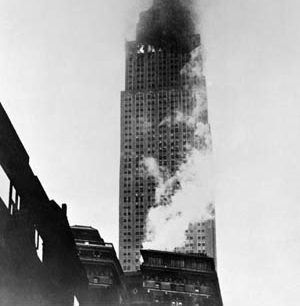
Another observer, Marvin Sherres, at work at his advertising agency nearby, told a reporter that there was a low rumble of thunder, followed by “a great flash, and orange and red flames leaped up the side of the building.”
Monsignor Patrick A. O’Boyle, executive director of Catholic War Relief Services whose offices were on the 79th floor of the Empire State Building, was walking along 34th Street at 7th Avenue with Father Edward E. Swanstrom, the organization’s assistant executive director, when they saw the plane go into the building. Fearing that the collision took place at or near the level of their offices, they began sprinting toward the disaster.
Thousands of other people also began running––some toward the scene and others away from it. But what was happening outside the Empire State Building was nothing compared to what was happening inside.
Concern About the Weather
Bill Smith seemingly had everything going for him. A tall, broad-shouldered graduate of the U.S. Military Academy at West Point (class of 1942), where he had lettered in football and earned All-American honors in lacrosse, was home from the war.
A veteran of an unheard-of 100 combat missions over France and Germany––34 of them as a pilot––Smith had been awarded two Distinguished Flying Crosses, four Air Medals, and the French Croix de Guerre. Somehow, against all odds, he had survived the war and was now stateside, enjoying a few days with his wife Martha, a former Army nurse, and their infant son in Watertown, Massachusetts, outside of Boston.
The 27-year-old lieutenant colonel, formally known as William Franklin Smith, Jr., was the deputy commander of the 457th Bombardment Group, a unit recently deployed from overseas. During its more than one year of combat service from its base at Glatton, England, the group had flown 235 missions, the last one being on Hitler’s birthday, April 20, 1945.
Smith, a Birmingham, Alabama, native who bore a vague resemblance to movie star Clark Gable, had been the popular commander of the group’s 750th Bombardment Squadron. Following Nazi Germany’s collapse, the group had returned to the United States in June 1945, and was in the process of reassembling at Bradley Field, the Army air base in Sioux Falls, in preparation for retraining in B-29s and possible deployment to the Pacific.
Colonel Smith had been on the final leg of a cross-country trip from South Dakota to the East Coast. Although described as “jaunty” and “devil-may-care” by his men, Smith’s wife detected an unusual air of apprehension about him as he prepared for his flight that gray and rainy July morning. “He was so dubious about the weather and said flying conditions would be poor,” she told a reporter.
The previous evening, she related, he had bounced their son, William F. Smith III, on his knee and said, “The youngster recognized me for the first time since I’ve been home. Gee, it makes a man feel big and important to have a son like ours.”
A Routine Flight
Colonel Smith’s mission that morning was a routine one, free from flak and enemy fighters: fly from Hanscom Army Air Base at New Bedford, Massachusetts, to Newark Army Air Field, where he was scheduled to pick up the Sioux Falls air base’s commander, Colonel H.E. Bogner, before returning to South Dakota. Smith decided to take a short furlough and spend a few days with Martha and little Billy where they were living near Boston.
The only other crewman along on the ride with Smith was 31-year-old Air Force Staff Sergeant Christopher S. Domitrovich, of Granite City, Illinois, who had accompanied him from the Sioux Falls base. As flight engineer aboard a C-47 of the 72nd Troop Carrier Squadron delivering paratroopers to Operation Market-Garden, Domitrovich had been shot down over Holland on September 17, 1944, and captured by the Germans, but escaped and made his way back to friendly lines. It is unknown what role Domitrovitch was to play on that morning’s flight, but it is likely that he was Smith’s flight engineer.
Smith allowed another serviceman, a 20-year-old U.S. Navy Aviation Machinist’s Mate named Albert G. Perna, to hitch a last-minute ride from Boston to the New York area. Perna was on his way home to be with his parents in Brooklyn, whose other son had died in May when his destroyer, Luce (DD-522), was sunk off the coast of Okinawa.
After performing his normal preflight checks, Smith warmed up the two engines, taxied to the end of the runway, rolled forward until the plane reached take-off speed, and then lifted off into the rain and low clouds at 8:55 AM.
Martha Smith, watching her husband take off, waved at the fast-disappearing plane. She didn’t realize that it was the last time she would ever see him.
Colonel Smith in the Heart of Manhattan
Slightly less than an hour after he had left New Bedford, Lt. Col. Smith and the two men with him neared New York. Looking out the bomber’s cockpit windows, all Smith could see below was a thick, gray blanket. Uncertain as to where he was, at 9:50 AM. he radioed La Guardia Field and was informed that he was already 15 miles south of the airport. The two men in the control tower, Victor Barden, chief operator, and Gerald Adie, supervising air traffic controller, advised him to circle back and land there rather than trying to make Newark.
An official report of the crash noted, “Within two minutes this plane showed up directly southeast of La Guardia, and Mr. Barden, believing it intended to land, gave it runway, wind direction, and velocity.” But Smith told the tower that his destination was Newark Army Air Field and that was where he wanted to go. The tower then called Airways Traffic Control who said that the ceiling at Newark was only 600 feet and repeated the recommendation that the B-25 try to land at La Guardia instead.
But Smith was insistent. Barden told Smith to stay over Queens, on the southeast side of La Guardia and south of the nearby Whitestone Bridge, while he contacted Army Advisory Flight Control for authorization to bring the plane into La Guardia. But Army Advisory Service said that the Civil Aviation Authority’s information that the 600-foot ceiling at Newark was wrong; it was actually 1,000 feet, with a visibility of two-and-a-quarter miles. When informed of this, Smith told the tower that he wanted to proceed to Newark, for that was where Col. Bogner was waiting for him.
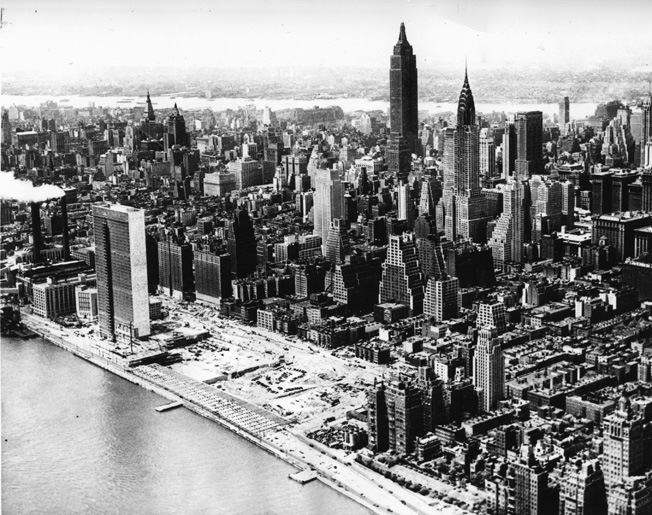
Barden then cleared Smith for Newark but advised him that he was unable to see the top of the Empire State Building from his perch in the tower. Smith, with no navigator on board and, erroneously believing that he was west of Manhattan over the Hudson River when, in fact, he was over the East River and heading into the heart of Manhattan, set a southwest course for what he thought was Newark.
Within seconds Smith found himself in a canyon of skyscrapers, totally confused and lost. People in offices and apartment buildings stared in amazement as the big plane roared by at eye level. They sensed that only a miracle could prevent a horrible tragedy. Having narrowly missed the Art Deco Chrysler Building and the Grand Central Office Building that stretched from 42nd to 56th Streets between Madison and Lexington Avenues, Smith tried to climb and veer away, but it was too late. What happened next was a Greek tragedy composed of many acts, all compressed into a few seconds.
A “Sheet of Flames”
The B-25 slammed into the north side of the 102-story building at the 79th floor level, some 913 feet above 34th Street, at an estimated 200 miles an hour. The impact tore an 18 by 20-foot hole in the outer wall. The left wing was sheared off and sailed down into Madison Avenue, a block away. Debris rained from the building.
Even worse, flaming fuel spewed from the plane’s ruptured tanks, engulfing almost the entire 79th floor in fire, instantly immolating many of the 15 to 20 young women working in the Catholic War Relief Services office, and pouring down the stairwells and elevator shafts like molten lava.
Paul Dearing, a 37-year-old volunteer public relations man working for the Catholic War Relief office, was trapped and saw the flames rushing toward him; he leaped from a window and died when he smashed onto a balcony five stories below. Another man, a building janitor, was the only person on the unoccupied 78th floor when the plane hit; he was trapped and killed by the flames. Catherine O’Connor, a worker with Catholic War Relief Services, herself injured, remembered the horror of that day: “The plane exploded within the building. There were five or six seconds– I was tottering on my feet trying to keep my balance– and three-quarters of the office was instantaneously consumed in this sheet of flame. One man was standing inside the flame. I could see him. It was a co-worker, Joe Fountain. His whole body was on fire. I kept calling to him, ‘Come on, Joe! Come on, Joe!’ “ (Although Fountain managed to walk out of the fire and escape the building, his burns were too severe and he would succumb to his injuries a few days later.)
At the moment of impact, one of the B-25’s engines ripped from its wing mount and hurtled across 80 feet of the 79th floor, through walls and partitions, and burst from the south side of the building, whereupon it crashed down upon a 12-story building at 10 West 33rd Street and started a fire that destroyed the penthouse studio of sculptor Henry Hering.
The other engine rammed its way through office walls, dropped into one of the 10 elevator shafts, and fell all the way to the sub-basement 1,000 feet below, taking an empty elevator car with it. As the plane hit, the operator of another elevator car on the south side, 20-year-old Betty Lou Oliver, had just opened her doors; the impact blew her out of the car and into the 80th floor lobby, badly injuring her. Two women working in an office suite on that floor, miraculously untouched by the disaster, rushed to her aid. They turned Betty Lou over to the operator of another elevator that had just arrived at the floor and implored him to transport her to the street level. As the car doors closed, a loud metallic snap was heard as the cable broke. This car, too, began its rapid descent toward certain doom.
Miraculously, the elevator system’s emergency hydraulics applied brakes to the plunging car, and the severed cables beneath the elevator piled up and acted like a coiled spring that slowed the elevator as it fell. Air that was trapped within the confined space of the shaft was also compressed by the falling car and built up pressure that slowed the elevator’s descent.
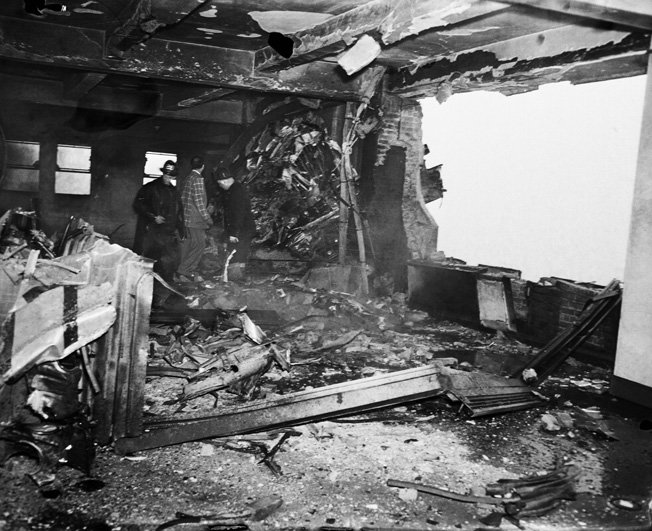
By this time, fire engines from all over the city were screaming from their stations and dashing to the pandemonium at 350 Fifth Avenue. Due to the damage to the elevators, the firemen were unable to ride above the 60th floor so, toting their hoses and other portable equipment, they clambered up the stairs. Fortunately, the building’s standpipes were undamaged, so the firemen had enough water with which to extinguish the blaze; most of the flames were put out within 40 minutes.
New York City Mayor Fiorello La Guardia, who had been at City Hall when the first alarms were sounded, rushed to the scene. He stood on the sidewalk near the Empire
State Building and watched as police cars, ambulances, and 41 fire trucks from 23 fire stations pulled up around the building and brave men rushed in to extinguish the fire and rescue survivors. Fuming, the portly, diminutive mayor shook his fists and muttered, “I told the Army not to fly over the city!”
Heroism in the Empire States Building
There were countless episodes of heroism performed that day. When the plane hit, flames shot up to the top of the elevator shaft that opened onto the observation deck, followed by a blast of dirt and debris, sending those on the deck (reports of the number of people there varied from three to 50 or 60) into a panic. Frank Powell, manager of the tower, led the group to safety down the fireproof stairwell, which was filling with people evacuating the other floors.
On west side of the 80th floor, less than 10 feet from where the plane had imbedded itself in the building, another drama was taking place. The floor held the offices of Arthur E. Palmer, a consulting engineer of the Caterpillar Tractor Company. Inside were Palmer and his assistant, D.J. Norden.
Palmer recalled, “We were lifted three feet out of our chairs and thrown to the floor– I thought it was a Jap bomb!” Flames from the floor below covered the windows. Palmer and Norden tried to flee into a corridor, but the hallway was also engulfed in fire. They saw a female elevator operator who was badly burned and screaming.
“She seemed to want to jump out the window,” Palmer said, but the two men restrained her and brought her back with them to their office, which was rapidly filling up with smoke.
Realizing that their office was probably a death trap, one of the men found a hammer and began using it to break through a wall into an adjoining suite. “When [the hole] was big enough, Norden went through,” Palmer recounted. “He took the elevator girl’s arms. I took her legs and we hauled and shoved her through. After I crawled out, we took her by the arms and led her through the empty office into a corridor that led us to a stairway.”
The trio descended about 30 floors until they came across an ad hoc aid station that physicians and rescuers had set up. As they turned the girl over to the medical personnel, she looked at them and said quietly, “Thanks for saving my life.”
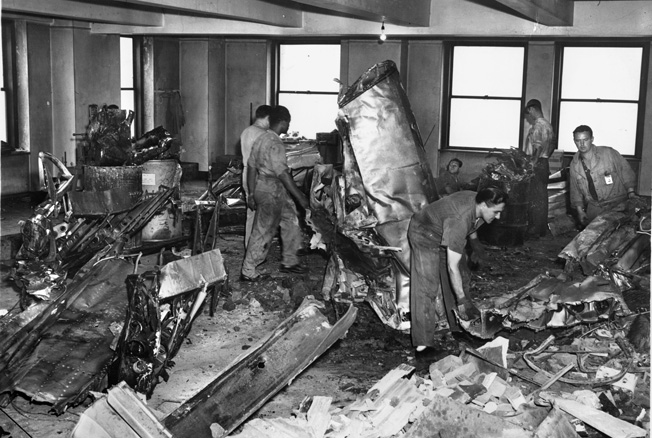
While all this was happening, coming up the stairs was 26-year-old Harold J. Smith, a medically discharged veteran. He had been on the 62nd floor when the building was rocked by the collision. Looking out a window, he could see frightened women many floors above him, smoke billowing from the window behind them, shouting for help. Without a second thought, Smith began “swimming upstream” against the flow of people coming down the stairs until he reached the 79th floor, which was in flames.
On Smith’s heels was a group of firefighters from Engine Company 54; together, they managed to rescue the hysterical survivors, many of them bruised, cut, and burned, and take them to safety on a lower floor.
Herbert Fabian, a 17-year-old boy from Brooklyn, was another rescuer. He found an unattended elevator at the main lobby, took it up, and rescued 20 people trapped between the 30th and 40th floors.
“Thank God the Navy’s Here!”
Another act of heroism was performed by Donald Malony, a 17-year-old Coast Guard apprentice pharmacist’s mate from Detroit. He had been training for nine months at the Coast Guard base at Groton, Connecticut, and was in New York on furlough.
When he saw the B-25 hit the building, he knew there would be casualties. In uniform, he rushed into a drugstore on the 33rd Street side of the building and demanded morphine, syringes, and first-aid kits. The startled clerk handed him “the largest first-aid kit he had, a quantity of morphine, a syringe, and several needles.”
Seeing firemen in the lobby heading for the building’s basement, Malony followed them down the stairs, where he encountered a group of firefighters cutting a hole
in the elevator shaft’s concrete wall and elevator car behind it. As the smallest person there, Malony said that the firemen urged him to crawl through the hole and into the smashed elevator.
“I got into the elevator,” he said, “and to the girl operator, who was badly burned from the flaming gasoline. The girl was conscious.” An injured man was also there, lying on the floor of the car. Seeing her rescuer in the dim light of the elevator car, she murmured, “Thank God the Navy’s here! I’ll be okay now.”
He helped her crawl through the opening, then helped the man out. Malony then went to work administering first aid to the woman. He noted that both her legs were badly burned but that her heavy elevator-operator uniform had protected most of the rest of her. He also helped the firemen provide aid for the car’s other occupant.
The teenage medic was not yet finished, however. Grabbing his first-aid kit, he began climbing the stairs. Unsure of exactly where the crash had occurred, Malony opened the stairwell door at every floor to see if any injured persons were there. At the 70th floor, he found three injured people and carried them, one at a time, down to the 67th floor for further treatment.
Above the 70th floor, he encountered pools of fuel and oil, cascades of water coming down the stairs (some of the firemen had taken the still-operable elevators up to the 78th and 79th floors and were dousing the fires), scorched walls, and a thick, choking smoke. Still not done with his mission of mercy, he made it to the 79th floor and helped the firemen and others in the grim task of retrieving the bodies, most of whom were burned beyond recognition.
Eleven Fatalities
In addition to the three men in the bomber, there were 11 fatalities in the building. Nine of the civilians killed were office workers while the others were a janitor and an elevator operator. There were 26 injured, including several firemen.
In the end, the accident caused $1 million in damages to the reinforced masonry structure and to other buildings struck by flying debris, but workers were able to repair the Empire State Building within just three months. Tenants also began returning to the Empire State Building as soon as repairs were completed; Catholic Relief Services still maintains offices on the 79th floor today.
In the aftermath of the crash, New York and the CAA (today the FAA) strengthened flight rules over the city, and the Army Air Force required additional training for pilots transitioning from combat to domestic flying.
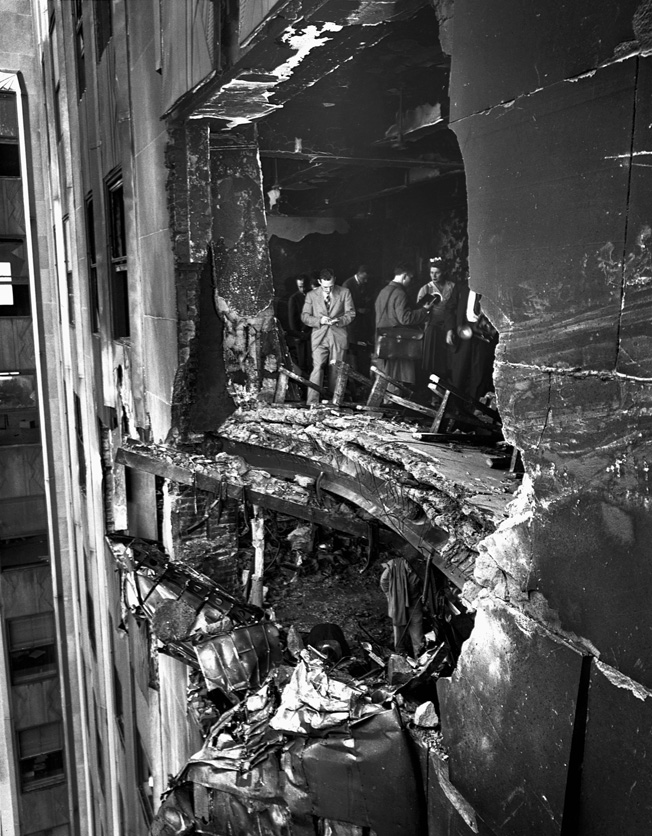
A few people exploited the accident for profit. Some boys picked up B-25 parts from the street below and sold them as souvenirs. And men who ordinarily sold looks at the stars through their telescopes at night enjoyed a brisk business selling close-up views of the gaping hole in the Empire State Building’s north wall during daytime.
Elevator operator Betty Lou Oliver recovered from her injuries. Five months after the accident, she returned the building but had no memory of what had happened to her. In the elevator equivalent of getting back on the horse from which one has been bucked, she took one of the cars and made a full trip in it. She continues to hold the record for surviving the longest fall in an elevator– over 1,000 feet.
In a eulogy for those who lost their lives on that rainy Saturday in July, the New York Times editorialized, “In his last moments, on a quiet Saturday morning, carrying no great load of explosives, poor Lieutenant Colonel Smith taught us something. The safety of cities, the peace of the world, the lives of people just as innocent as those at work in the Empire State Building, the future of civilized existence upon this earth, all depend on as large an American contingent, as vast and concentrated an American effort, as much sacrifice of that sacred cow known as sovereignty as the truly desperate situation requires. We cannot play with the idea of peace. If we do so, this island of Manhattan and its people, and other islands and continents and their people, will some day be as one with Nineveh and Tyre.”
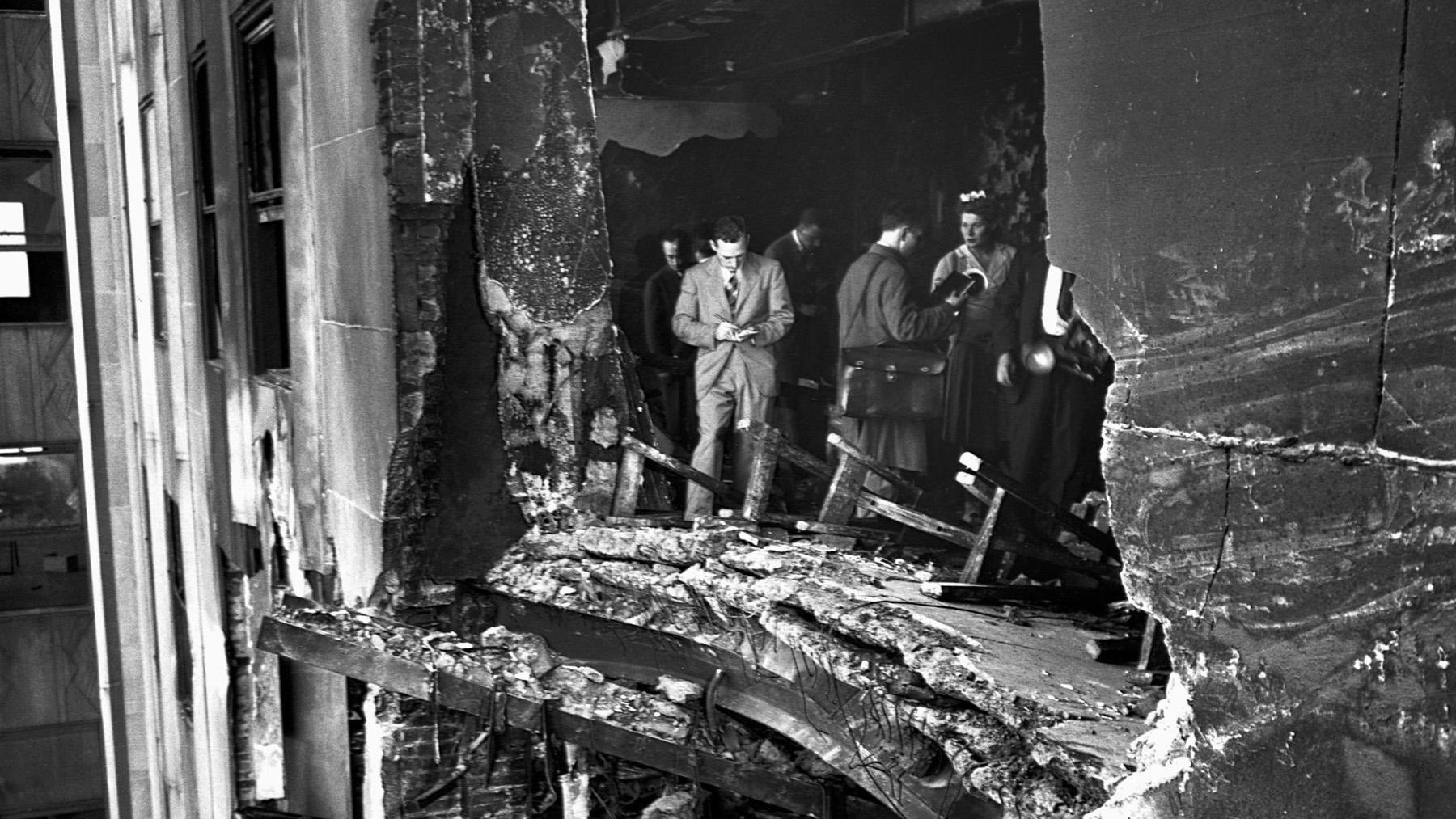
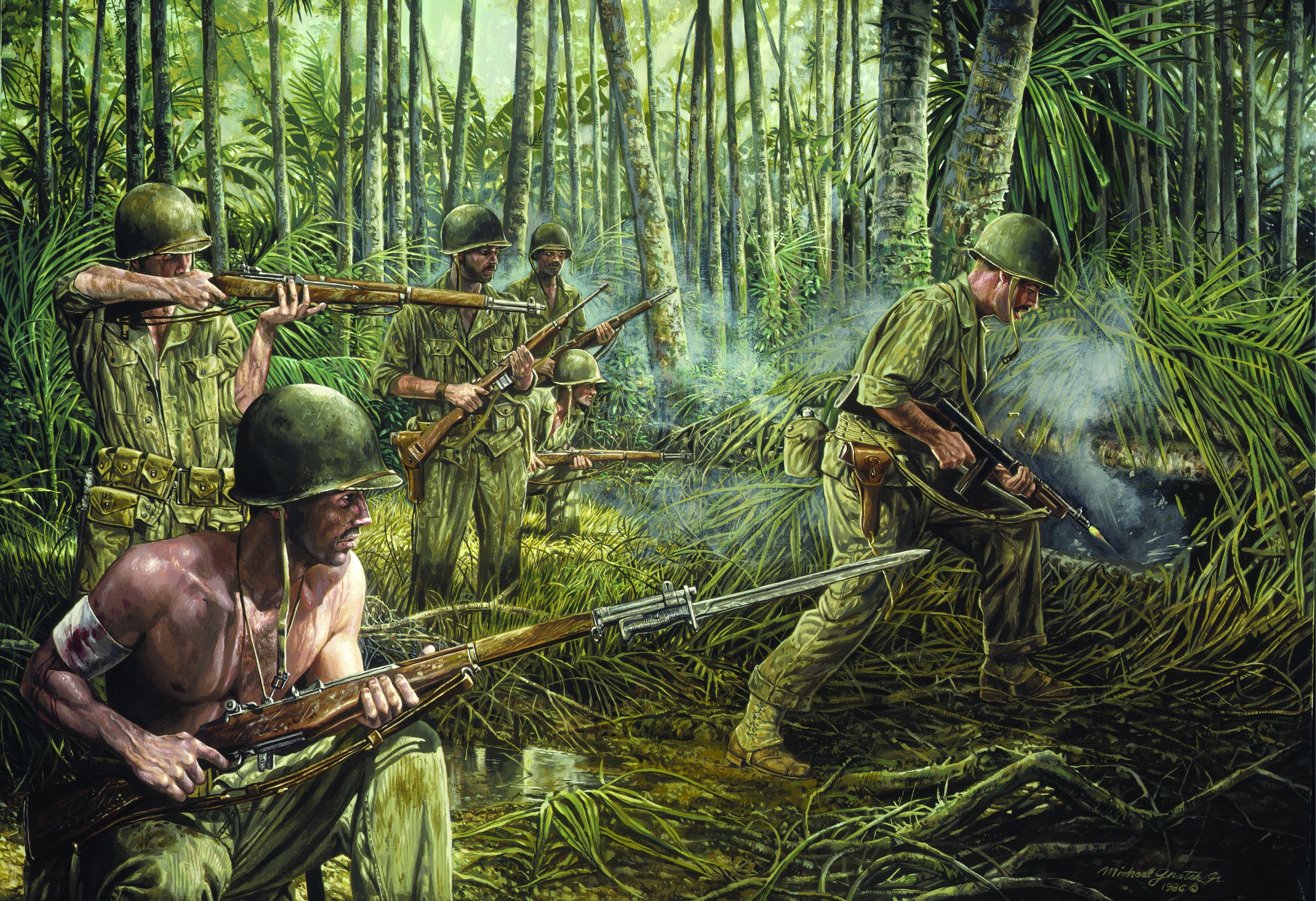
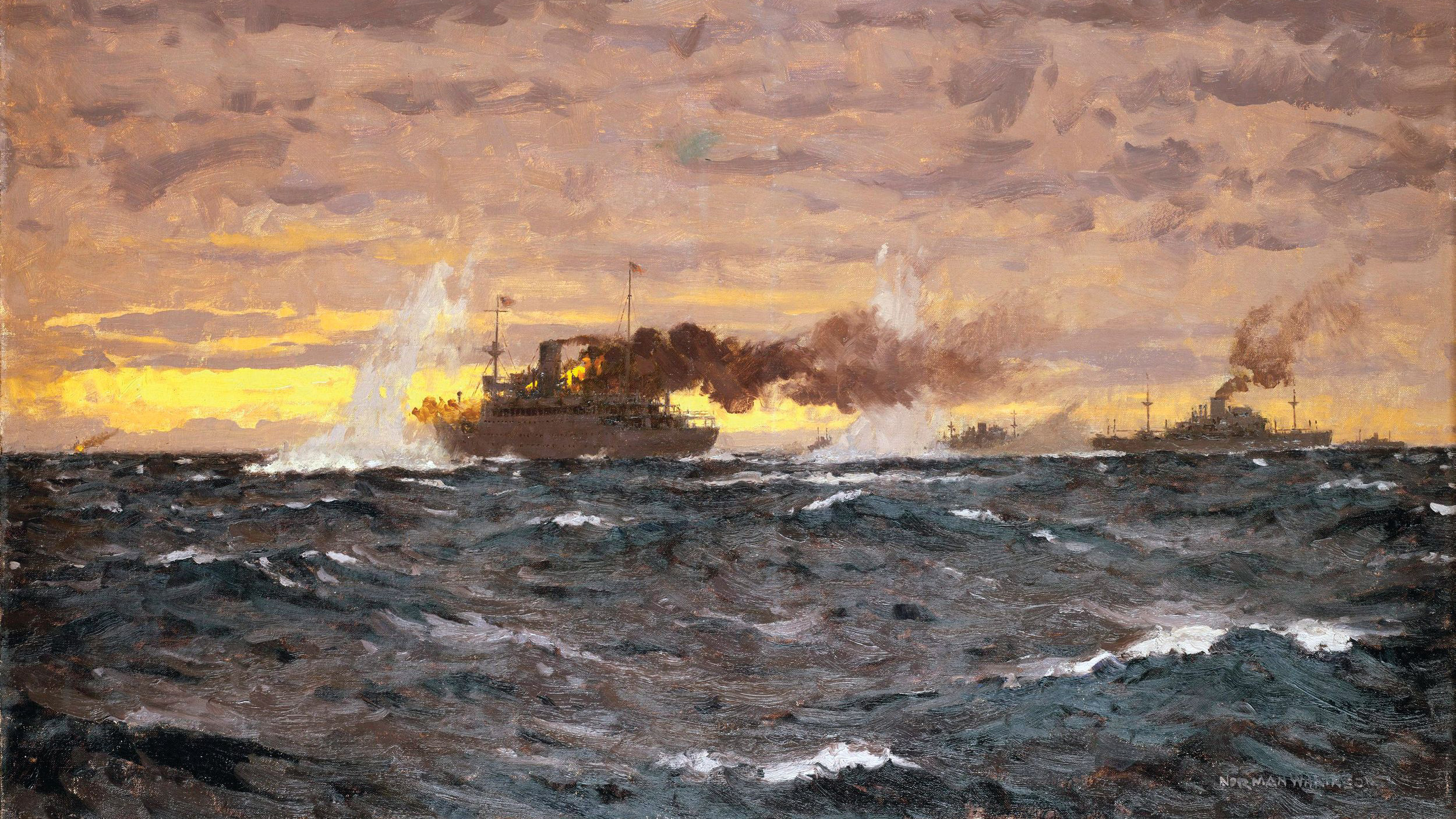
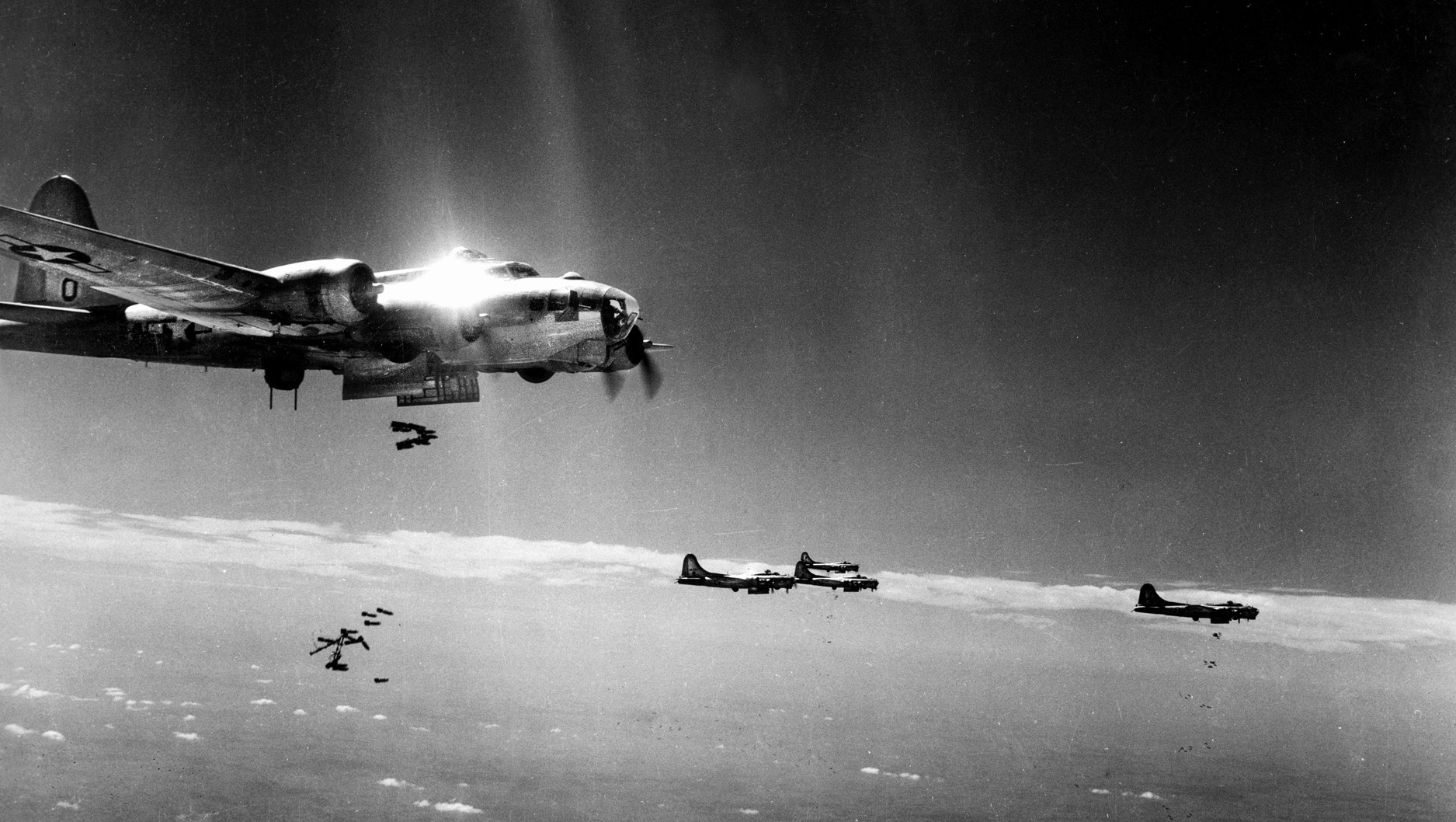
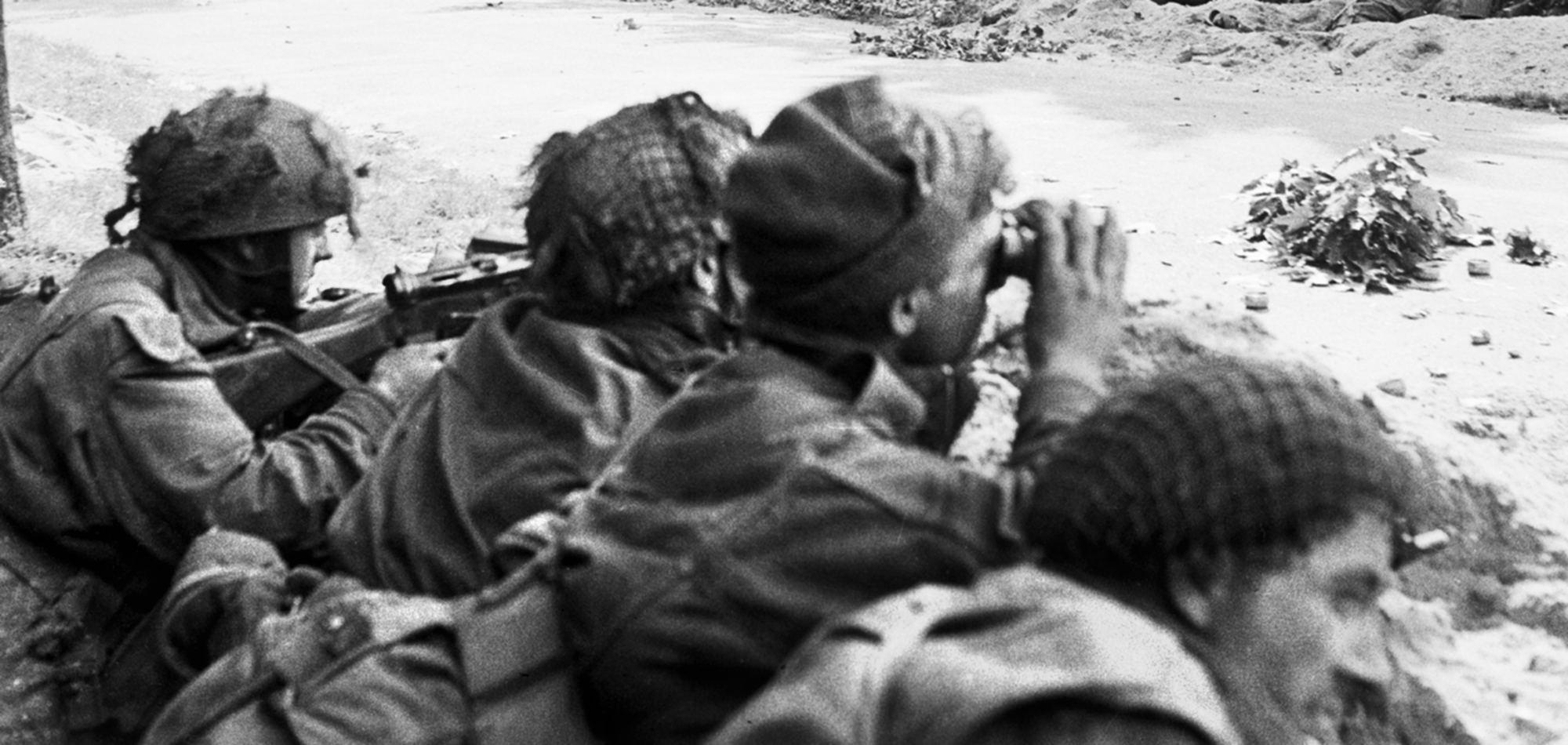
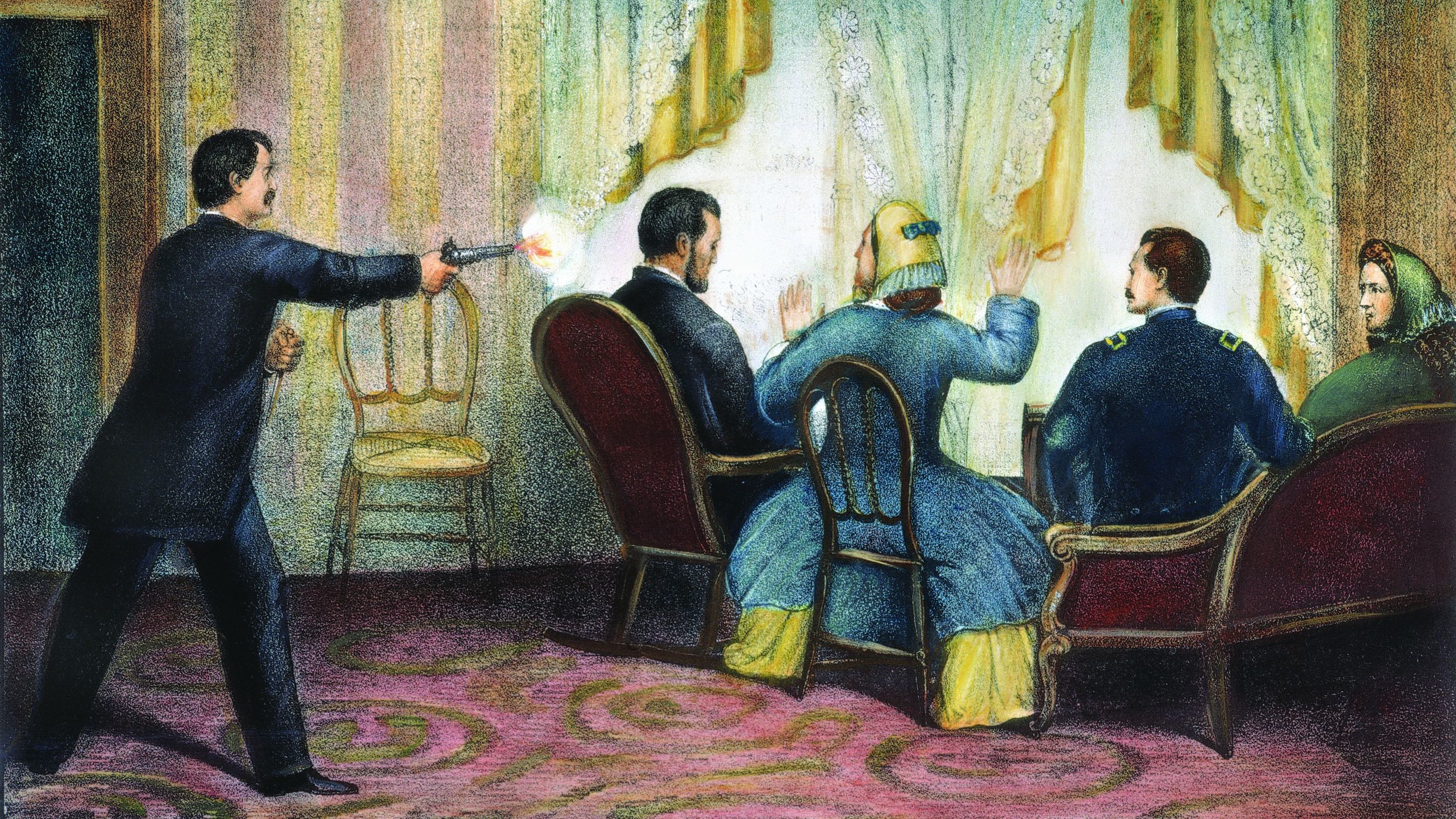
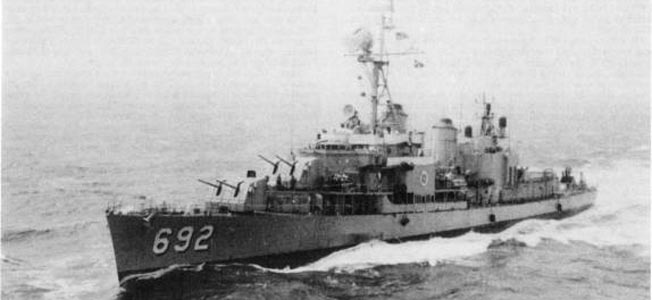
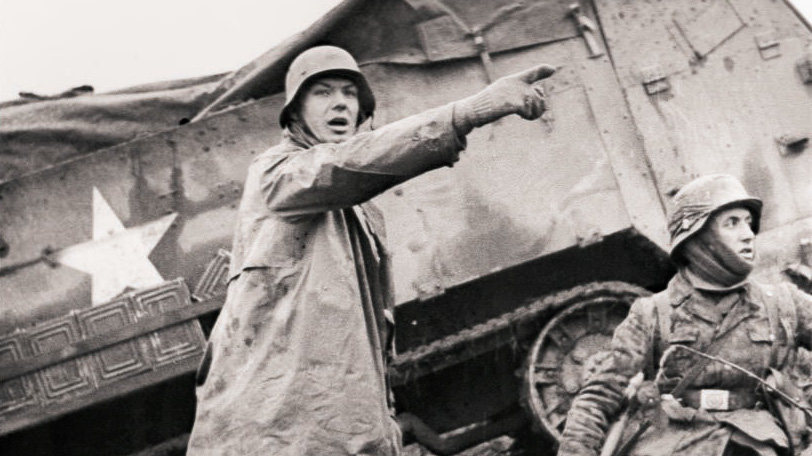
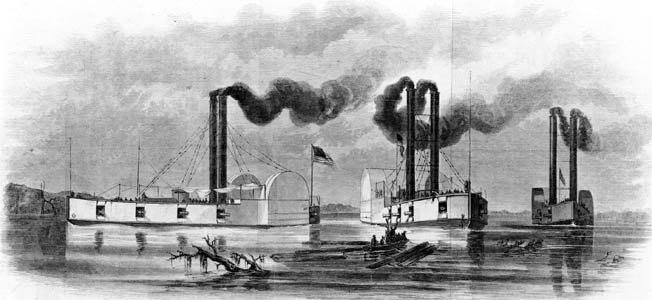
Join The Conversation
Comments
View All Comments